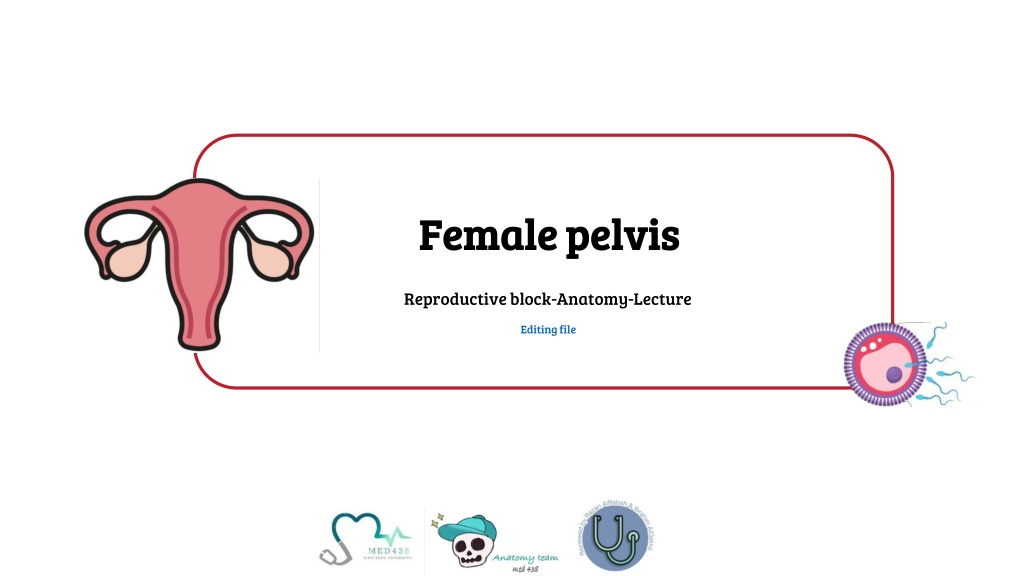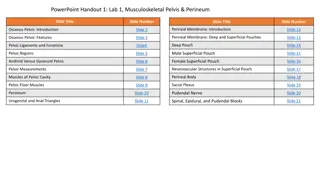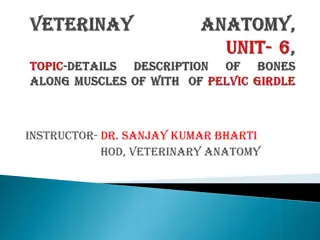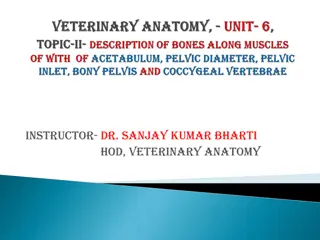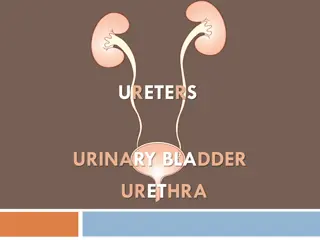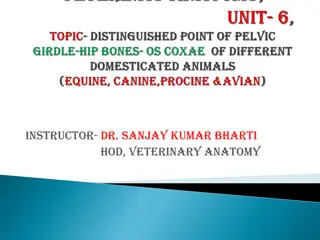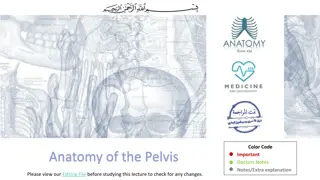Understanding Female Pelvis Anatomy and Differences from Male Pelvis
The female pelvis anatomy lecture covers the pelvic wall, bones, joints, and muscles. It explains the boundaries, subdivisions, and types of female pelvis, along with details on pelvic walls, floor, and diaphragm components. Additionally, it includes information on arterial, nerve, lymph, and venous supplies. The content details the bony pelvis structure, including bones, joints, and muscles, and highlights the differences between male and female pelvis types.
Download Presentation

Please find below an Image/Link to download the presentation.
The content on the website is provided AS IS for your information and personal use only. It may not be sold, licensed, or shared on other websites without obtaining consent from the author. Download presentation by click this link. If you encounter any issues during the download, it is possible that the publisher has removed the file from their server.
E N D
Presentation Transcript
Female pelvis Female pelvis Reproductive block-Anatomy-Lecture Editing file
Color guide Color guide: : Only in boys slides in Green Only in girls slides in Purple important in Red Red Notes in Grey Grey Green Purple Objectives Objectives At the end of the lecture, students should be able to: Describe the anatomy of the pelvic wall, bones, joints & muscles. Describe the boundaries and subdivisions of the pelvis. Differentiate the different types of the female pelvis. Describe the pelvic walls & floor. Describe the components & function of the pelvic diaphragm. List the arterial & nerve supply. List the lymph & venous drainage of the pelvis.
Introduction Introduction The bony pelvis is composed of 4bones, connected by 4joints and lined by 4muscles. The bony pelvis with its joints and muscles form a strong basin-shapedstructure (with multiple foramina). The pelvis contains and protects the: 1) Lower parts of the alimentary tract. 2) Urinary tract. 3) Internal organs of reproduction. Four Bones Four Bones 1. 2. Two hip bones, which form the anterior Sacrumand coccyx, which form the posterior anterior &lateral posterior llaw lateral sllaw . . Sacroiliac joints Four Joints Four Joints 1. 1. 2. 2. 3. 3. Anteriorly: Anteriorly: Symphysis pubis(2ryCartilaginous joint). Posteriorly: Posteriorly: Sacrococcygealjoint (2ryCartilaginous joint). Posterolaterally: Posterolaterally: Two Sacroiliacjoints (Synovial joints, plain variety). Sacrococcygeal joint Symphysis pubis 3 3
Pelvis Pelvis The pelvis is divided into two parts by the pelvic brim (inlet) The pelvis is divided into two parts by the pelvic brim (inlet). . BELOW ABOVE True or lesser pelvis True or lesser pelvis ) Has 3 parts( False or greater pelvis False or greater pelvis ) Part of the abdominal cavity( It supports the lower abdominal contents, it s bounded by : Anteriorly Lower part of the anterior abdominal wall. Posteriorly Lumbar vertebrae . Laterally Iliac fossae and the iliacus muscle. 02 03 Inlet Inlet Outlet Outlet Cavity Cavity 01 )Oval/circular shape:( )Diamond shape:( The cavity is a short, curved canal, with a shallow anterior wall and a deeper posterior wall. It lies between the inlet and the outlet. Anteriorly Symphysis pubis (lower border). Posteriorly Coccyx. Anterolaterally Ischiopubic ramus. Posterolaterally Sacrotuberous ligament. Anteriorly Symphysis pubis (upper border). Posteriorly Promontory & ala of sacrum. Laterally Iliopectineal (arcuate) lines. 4 4
Main difference between & pelvis Main difference between & pelvis In Males In Males: : The Sacrum is usually longer, narrowest and curved. The promontory and the ischial spines are inverted. In Females In Females: : The Sacrumis usually widerand shorter . The Angle of the pubic arch is wider The promontoryand the ischial spinesare less projecting. .( 85 - 80 ) Female Female Male Male Types of Female Bony Pelvis Types of Female Bony Pelvis: : Anthropoid (has both male and female characteristics) Android (resembles male pelvis) Gynecoid (typical female type) Platypelloid (least common) Information of the shape and dimensions of the female pelvis is of great importance for obstetrics. Why? because it is the bony canal through which the child passes during birth. Gynaecoid pelvis: considered the most suitable female pelvic shape for childbirth. 5 5
Pelvic Walls Pelvic Walls The pelvis has 4 walls. The walls are formed by bones and ligaments that are lined with muscles covered with fascia and parietal peritoneum. Posterior pelvic wall deep & wide Anterior pelvic wall very narrow 1) 2) 3) 1) 2) 3) It is the shallowest wall and has no muscles, it s formed by : The posterior surfaces of the bodies of the pubic bones. The 2pubic rami. The symphysis pubis. It is large & deeper, formed by : Sacrum. Coccyx. Piriformis muscles & their covering of partial pelvic fascia. Inferior pelvic wall (pelvic floor) Lateral pelvic wall Basin-like structure which supports the pelvic viscera and is formed by the pelvic diaphragm. It stretches across the lower part of the true pelvis and divides it into : Main (true) pelvic cavity above, which contains the pelvic viscera. Perineum below which carries the external genital organs. 1) It is formed by : Part of the hip bone below the pelvic inlet. Obturator internus and its covering & obturator fascia. Sacrotuberous ligament. Sacrospinous ligament. 2) 1) 3) 4) 2) 6 6
Pelvic Muscles Pelvic Muscles ) 4 Muscles) 01 02 03 04 Piriformis Piriformis )part of posterior pelvic wall ( Obturator Internus Obturator Internus ) part of lateral pelvic wall( Levator Ani Levator Ani )wide thin sheet-like muscle that has a linear origin( Coccygeus Coccygeus Piriformis Piriformis Obturator Internus Obturator Internus 0 1 Muscle Muscle 02 Pelvic surface of the middle 3 sacral vertebrae . Inner surface of the obturator membrane and the hip bone. Origin Origin It leaves the pelvis through the greater sciatic foramen, to be inserted into the Greater trochanter of the femur. It leaves the pelvis through the lesser sciatic foramen, to be inserted into the Greater trochanter of the femur. Insertion Insertion Nerve to obturator internus (from sacral plexus). Nerve supply Nerve supply Sacral plexus. Action Action Lateral rotator of the femur at the hip joint. 7 7
Pelvis Diaphragm Pelvis Diaphragm It is formed by the levator ani and the coccygeus muscles and their covering fasciae. It is incomplete anteriorly to allow passage of: 1) Urethra in males. 2) Urethra and vagina in females. Levator Ani Levator Ani Coccygeus Coccygeus Muscle Muscle Muscle Muscle 03 04 1) 2) 3) Back of the body of the pubis. Tendinous arch of the obturator fascia. Spine of the ischium. Origin Origin Origin Origin Ischial spine. Coccygeus muscle has the same attachment as the sacrospinous ligament. Its fibers are divided into 3 parts: Pubococcygeus, Puborectalis & Iliococcygeus. Fibers Fibers Lower end of sacrum & coccyx. Insertion Insertion Nerve Nerve supply supply 1) 2) Perineal branch of the 4th sacral nerve (S Perineal branch of the pudendal nerve lower surface. 4 ( upper surface. Nerve Nerve supply supply 1) The muscles of the two sides form an efficient muscular sling that supports and maintains the pelvic viscera in position. They resistthe rise in intra pelvic pressureduring the straining and expulsive efforts of the abdominal muscles (as in coughing.( They have a very important role in maintaining fecal continence (puborectalis) by acting as a sphincter at the anorectal junction. They serve as a vaginal sphincter in the female. branches of the 4th and 5th sacral nerves. 2) Action Action 3) Assist the levator ani in supporting the pelvic viscera. Action Action 4) 8 8
Levatores Ani Muscles ( Levatores Ani Muscles (Fibers( ( . . Iliococcygeus Iliococcygeusor 3 3 Ischiococcygeus Ischiococcygeus )Posterior part( or 1 1 . . Pubococcygeus Pubococcygeus (trap roiretnA) Origin: originates from the posterior surface of the body of the pubis . Insertion: inserted into the perineal body & coccyx . Action: stabilizes the perineal body & forms a sling around the prostate or the vagina. Insertion: Inserted into the anococcygeal body and the coccyx. Origin of Ischiococcygeus: arises from the ischial spine. . . Puborectalis Puborectalis )Intermediate part( 2 2 Levator prostate: Supports prostate. Stabilizes perineal body. forms a sling around the recto-anal Junction . It has a very important role in maintaining fecal continence. 1) 2) Sphincter vaginae: constricts the vagina. Stabilizes perineal body. Ischiococcygeus 1) 2) 9
Arterial Supply of the Pelvis Arterial Supply of the Pelvis 01 01 Internal iliac artery Internal iliac artery 2 eht fo enO :(AII) terminal branch of the Common iliac artery. Course: Course: inlet It divides at the upper border of the greater sciatic foramen into: Anterior & Posterior divisions. tnioj cailiorcas eht fo tnorf ni sesirA It descends downward & backwards over the pelvic 1. 1. 2. 2. 3. 3. Iliolumbar artery Iliolumbar artery Lateral Sacral Lateral Sacralarteries Superior Gluteal artery Superior Gluteal artery Supplies: Posterior abdominal wall, Posterior pelvic wall & Gluteal region . Posterior Posterior Division Division arteries ) 2 branches) Parietal Parietal 1. 1. 2. 2. Obturator artery Obturator artery Inferior Gluteal Inferior Glutealartery Supplies: Gluteal region, Perineum, Pelvic viscera, Medial (adductor) region of thigh (by obturator artery), The fetus (through the umbilical arteries) . artery 1. 1. Umbilical artery: Umbilical artery: yretra siht fo trap latsid eht :yretra lacisev roirepus eht sevig tnemagil lacilibmu laidem eht smrof dna desorbif . Inferior Vesical Inferior Vesicalartery in male or vaginal in female: artery in male or vaginal in female: In the male it supplies the Prostate and the Seminal Vesicles. It also gives the artery of the Vas Deferens. Middle Rectal artery Middle Rectal artery Internal Pudendal artery: Internal Pudendal artery: It is the main arterial supply to the perineum. 2. 2. Anterior Anterior Division Division Visceral Visceral 3. 3. 4. 4. 1. 1. 2. 2. Vaginal artery: Vaginal artery: Replaces the inferior vesical artery. Uterine artery Uterine artery:* :* eniretu & suretu eht seilppus dna ylroirepus reterU eht sessorC * .ebutMay be wrongly ligated in hysterectomy. = damage to ureter, leading to renal failure . Visceral Visceral ) )Female Female( ( 02 02 Ovarian artery Ovarian artery atroa lanimodbA . eht morf sesirA :(elamef ni) 10 10
Supply of the Pelvis Supply of the Pelvis Venous drainage Venous drainage Nerve Supply Nerve Supply Somatic Internal iliac veins: It collect tributaries corresponding to the branches of the internal iliac artery. joins the external iliac vein in front of the sacroiliac joint to form the common iliac vein (the common iliac veins join at the level of L5 to give the inferior vena cava). Ovarian vein: Right Right otni sniard niev CVI . Left Left otni sniard niev laner tfel nieV . Sacral plexus : from ventral (anterior rami) of L S + (knurt larcasobmul) 1 S , 2 S , 3 It gives pudendal nerve to perineum. Autonomic 5 L & 4 and most of S 4 . Sympathetic (Pelvic part of sympathetic trunk): It is the continuation of the abdominal part of sympathetic trunk. It descends in front of the ala of the sacrum . The 2sympathetic trunks unite inferiorly in front of the coccyx and form a single ganglion (Ganglion Impar). Superior & Inferior Hypogastric plexuses. Parasympathetic (Pelvic splanchnic nerves): civlep ot srebif cinoilgnagerp tugdnih & arecsiv . Lymphatic drainage Lymphatic drainage The lymph nodes and vessels are arranged along the main blood vessels. Thus, there are external iliac nodes, internal iliac nodes, and common iliac nodes. Lymph from Common iliac nodes & the (Ovaries, uterine tubes & fundus of uterus) passes to Lateral aortic Lateral aortic)paraaortic paraaortic sedon ( :( 4 & 3 , S morF) 2 . 11 11
QUIZ QUIZ Q1 Q2 Q3 Q4 Q5 Q6 Q7 Q8 C A C D C D B C Q Q 1 1 : : The Sacroiliac joints is: A. Anterolateral -Cartilaginous joint B. Posteriomedial -Cartilaginous joint C. Posterolateral - Synovial joint D. Anteriomedial - Synovial joint Q Q 2 2 : : The False (greater) pelvis is bounded posteriorly by: A.Lumbar vertebrae B. Sacral vertebrae C.Iliac fossa & iliacus muscle D. Promontory Q Q 3 3 : : Which of the following is falseabout the INLET of true pelvis? A. It s part of lesser pelvis B. It s bounded anteriorly by Symphysis pubis C. It s bounded posteriorly by Coccyx D. It s bounded laterally by Iliopectineal (arcuate) lines Q Q 4 4 : : Which of the following is female pubic arch angle? A. 45 B. 50 - 60 C. 70 D. 80 - 85 Q Q 5 5 : : Which of the following is formed by Sacrotuberous ligament? A. Anterior pelvic wall B. Posterior pelvic wall C. Lateral pelvic wall D. Inferior pelvic wall (floor) Q Q 6 6 : : The nerve supply of levator ani muscles: A. Branches of 4th and 5th sacral nerves B.Branche 4th sacral nerve C. Branch of the pudendal nerve D. Both B & C Q Q 7 7 : : The relaxation of which of the following muscle fibers leads to defecation? A. Pubococcygeus B. Puborectalis C. Iliococcygeus D. Coccygeus Q Q 8 8 : : The ovarian artery originated from: A. Uterine artery B. Vaginal artery C. Abdominal aorta D. Internal iliac artery 12 12
Members board Members board Team leaders Team leaders Abdulrahman Shadid Abdulrahman Shadid Ateen Almutairi Ateen Almutairi Boys team Boys team : : Girls team Girls team: : Mohammed Al Mohammed Al- -huqbani Salman Alagla Salman Alagla Ziyad Al Ziyad Al- -jofan jofan Ali Aldawood Ali Aldawood Khalid Nagshabandi Khalid Nagshabandi Sameh nuser Sameh nuser Abdullah Basamh Abdullah Basamh Alwaleed Alsaleh Alwaleed Alsaleh Mohaned Makkawi Mohaned Makkawi Abdullah Alghamdi Abdullah Alghamdi huqbani Ajeed Al Rashoud Ajeed Al Rashoud Taif Alotaibi Taif Alotaibi Noura Al Turki Noura Al Turki Amirah Al Amirah Al- -Zahrani Alhanouf Al Alhanouf Al- -haluli Sara Al Sara Al- -Abdulkarem Abdulkarem Renad Al Haqbani Renad Al Haqbani Nouf Al Humaidhi Nouf Al Humaidhi Jude Al Khalifah Jude Al Khalifah Nouf Al Hussaini Nouf Al Hussaini Danah Al Halees Danah Al Halees Rema Al Mutawa Rema Al Mutawa Maha Al Nahdi Maha Al Nahdi Razan Al zohaifi Razan Al zohaifi Ghalia Alnufaei Ghalia Alnufaei Zahrani haluli
